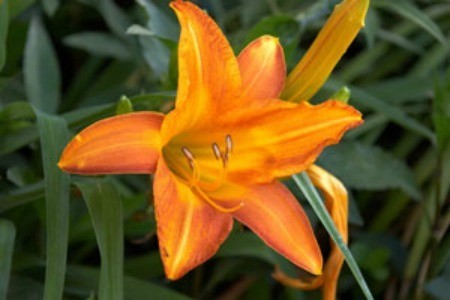
When I moved to my present home, I inherited a big, unruly bed of faded orange daylilies. For a while I contemplated getting rid of them, but the bed was large and well-established and it seemed like a lot of work. Then I become friends with an avid daylily collector, and before you know it, I was exploring the many (MANY) types of daylilies available. With the hundreds and hundreds of different lilies growing in his garden, I was certain he had one of the largest collections in the world. That is, until I found out there are more than 50,000 daylily cultivars!
In Greek, Hemerocallis, the botanical name of the daylily, means "beauty for a day" because each flower lasts only a day. So why would anyone grow flowers that last only one day? To begin with, a daylily grows many scapes (flower stems) that produce dozens of buds. This actually keeps the plant in constant bloom for weeks. There have also been many changes in daylily development over the past few years, resulting in stronger plants that produce more flowers for a longer blooming cycle. Daylilies are also very easy to grow and maintain, they survive in all types of climates and they grow in almost any soil. A truly forgiving plant, any daylily enthusiast will tell you, they are the perfect perennials.
Gardeners love daylilies for their varied shapes and sizes and for their wide range of colors - all the colors of the rainbow, except blue. They make excellent ground covers on slopes and look lovely planted against fences, on decks or patios, and peeking through wrought iron railings or when adding splashes of color to borders and beds. They give the best color when planted in large groups or sweeping swaths in the garden.
Daylilies grow from eight inches to five feet tall with varieties featuring flowers as small as two inches or as big as eight inches. They usually bloom the year they are planted and grow quickly to form clumps. Some daylilies "re-bloom," that is they flower once early in the season and again in the fall. Others bloom in succession for a few months. As with most perennials, "deadheading" encourages more flowers.
Daylilies are very adaptable, but prefer nutrient-rich, well-drained soil in a sunny location. Planting them in the shade will result in a leafy spikes with few flowers and care should be taken to keep them away from trees and shrubs that will compete for nutrients. The exception to this is in southern states, where many daylilies, especially those with dark colored flowers, grow better if given some afternoon shade. In general, most daylilies are drought tolerant and need very little fertilizing (once yearly if at all). Personally, mine seem to thrive on neglect.
Planting daylilies is best done in the spring or autumn. Recommended spacing is 18 to 24 inches apart, just below the surface of the soil. Planting holes should be only slightly larger than the root mass.
Daylilies look best if they are cared for throughout the season. At the beginning of the growing season, remove any old and dead foliage from the clumps. Remove blooms after flowering to keep your lilies neat and to encourage more flowrs. When all the flowers on a scape are finished, cut it close to the ground. Daylilies are not very susceptible to pests and then only suffer minor damage. Some of the more common pests are aphids, spider mites, thrips, slugs, and snails.
Dividing daylilies is not required, but it can invigorate plants if they become crowded and overgrown. Plants can be divided anytime they are not flowering.
Rare varieties of daylilies can command prices as high as $300 a plant among avid collectors. Don't worry though, there are thousands of fabulous varieties available for the rest of us in the $3 to $10 range. A quick search online will put you in touch with many resources for collecting daylilies and point you toward instructions on how you can hybridize your own to create totally new varieties. The American Hemerocallis Society (www.daylilies.org) contains information on every aspect of growing and collecting daylilies, including databases, publications and calendars for local, regional and national club activities.

About The Author: Ellen Brown is an environmental writer and photographer and the owner of Sustainable Media, an environmental media company that specializes in helping businesses and organizations promote eco-friendly products and services. Contact her on the web at http://www.sustainable-media.com
Add your voice! Click below to comment. ThriftyFun is powered by your wisdom!